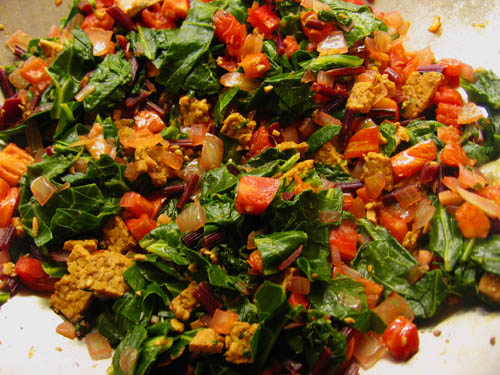Last Sunday I woke up at a friend’s place after a big night out, having slept no more than a few hours, and drove home in the midst of a monsoon. The rain was coming down so hard my windshield wipers were inadequate, and I seriously considered pulling over to wait out the rain even though the trip between our houses is only 40 blocks or so. The sky was so dark, and the light so filtered, that it seemed perennially like the hour just before dawn. When I finally made it into my house I was cold and wet and exhausted and it should have been the perfect day to curl up with a book and my cat and listen to the rain come down.

It may look ugly, but it tastes amazing!
But instead, for some reason, I wanted to make lasagna. Butternut squash white lasagna with spinach and beet greens, to be exact. Vegan lasagna is quite an undertaking, since you have to make the ricotta substitute by hand, and white lasagna is even more work because it also requires the concoction of a vegan bechamel or other white sauce. And of course I didn’t have any tofu with which to make my ricotta, and I was worried I didn’t have enough gluten-free lasagna noodles on hand, either.

Sigh... it's so hard to make a pan of lasagna look pretty!
So I put on my slicker and my pink plaid rain boots and headed out into the storm to the market a few blocks from my house. I picked up tofu and noodles and the ingredients for vinegret and slogged back home. By the time I got home, my jeans were soaked through to the skin. But it was worth it. I really, really wanted that lasagna. People kept calling to invite me over but I couldn’t imagine getting back in the car in the rain. And as I may have mentioned, I really wanted that lasagna.

Super delicious, rich, creamy cashew ricotta
I tried some new things this time. I made Veganomicon’s cashew ricotta (which is still tofu-based but made much richer and creamier by the addition of cashews) and tried out a new vegan bechamel using Mimic Creme, a nut-based soy-free cream substitute. My recipe is basically cadged together from different sources, but the result is divine!
Vegan Gluten-Free Butternut Squash White Lasagna with Spinach and Beet Greens
Based on recipes from Coconut & Lime, Book of Yum, and Veganomicon
Ingredients
1 box gluten-free lasagna noodles (I prefer Tinkyada brand)
1 1/2 cups toasted walnuts (these are for topping the lasagna after it comes out of the oven)
Filling:
1 medium to large butternut squash, sliced lengthwise and seeds removed or 2 packages frozen butternut squash
1 large bunch Swiss chard or beet greens, chopped
1 large bunch spinach, chopped
1 medium onion, diced
5 cloves garlic, minced
1 tablespoon olive oil
1 teaspoon chopped fresh sage (or dried sage)
1 teaspoon smoked paprika
1/4 teaspoon salt
1/4 teaspoon white pepper
1/8 teaspoon nutmeg
Cashew Ricotta, a double recipe of a Veganomicon
recipe:
1 cup raw cashew pieces (approximately 4 ounces)
1/2 cup fresh lemon juice
4 cloves fresh or roasted garlic
2 pounds firm tofu, drained and crumbled
3 teaspoons dried basil
3 teaspoons salt
Vegan Bechamel, adapted from Book of Yum:
scant 1/2 cup flavorful GF flour (brown rice, chickpea, etc.)
2 cups Mimic Creme
1 cup rice (almond or soy, if not intolerant) milk
bay leaf
salt, freshly ground pepper
fresh nutmeg, grated
Directions:
If using fresh squash: Preheat oven to 400. Cut squash in half lengthwise and remove seeds. Brush the butternut squash with olive oil. Place cut side down on a parchment lined baking sheet. Bake for 30-40 minutes or until fork tender. Allow to cool slightly. Scoop out the insides.
If using frozen squash: Steam according to package directions.
For either baked or steamed frozen squash: Mash. It should yield about 3 1/2 to 4 cups of squash (more is fine). Season with salt and pepper. Set aside.
Meanwhile, cook the noodles according to package instructions. Drain and arrange in a single layer on baking sheets until ready for use.
For the filling: Heat the oil in a large skillet. Saute the onion and garlic until fragrant, then add the chard, spinach, and sage. Saute until the greens are soft. Allow to cool slightly then combine with the cashew ricotta, nutmeg, salt, pepper and paprika.
To make cashew ricotta:
In a food processor, blend together the cashews, lemon juice, olive oil, and garlic until a thick creamy paste forms. Add the crumbled tofu to the food processor, working in two or more batches if necessary, until the mixture is thick and well blended. Blend in the basil and salt.
To make vegan bechamel:
Make your bechamel sauce by combining ingredients and let the mixture come to a low boil, whisking constantly until sauce is thickened. Simmer for a few minutes with bay leaf and seasonings and then reserve.
To assemble: Preheat oven to 375. Spread some sauce on the bottom of a 9×13 inch pan. Top with noodles then layer with a layer of squash then the chard-ricotta mixture and drizzle with sauce. Repeat until the pan is full, then top with a final layer of noodle and the remaining sauce.
Bake covered for 30-40 minutes, then remove cover and bake for another 10 or so minutes. Allow to sit about 5 minutes before slicing and serving. Serve topped with toasted walnuts.






